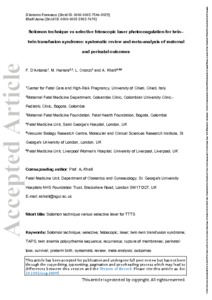D'Antonio, F; Herrera, M; Oronzii, L; Khalil, A
(2022)
Solomon technique vs selective fetoscopic laser photocoagulation for twin-twin transfusion syndrome: systematic review and meta-analysis of maternal and perinatal outcomes.
Ultrasound Obstet Gynecol, 60 (6).
pp. 731-738.
ISSN 1469-0705
https://doi.org/10.1002/uog.26095
SGUL Authors: Khalil, Asma
![[img]](https://openaccess.sgul.ac.uk/114925/1.hassmallThumbnailVersion/Ultrasound%20in%20Obstet%20Gyne%20-%202022%20-%20D%20Antonio%20-%20Solomon%20technique%20vs%20selective%20fetoscopic%20laser%20photocoagulation%20for%20twin.pdf)  Preview |
|
PDF
Accepted Version
Available under License ["licenses_description_publisher" not defined].
Download (551kB)
| Preview
|
Abstract
Objective
To ascertain maternal and perinatal outcomes of monochorionic twin pregnancies complicated by twin–twin transfusion syndrome (TTTS) treated with the Solomon technique compared with selective fetoscopic laser photocoagulation (SFLP) of placental anastomoses.
Methods
MEDLINE, EMBASE and The Cochrane Library were searched to identify relevant studies. The outcomes observed were perinatal loss and survival, preterm prelabor rupture of membranes (PPROM), preterm birth (PTB), gestational age (GA) at delivery, interval between laser treatment and delivery, maternal bleeding, septostomy or chorioamniotic separation, placental abruption, twin anemia–polycythemia sequence (TAPS), recurrence of TTTS, neonatal morbidity and neurological morbidity. Random-effects head-to-head meta-analyses were used to analyze the data. Pooled odds ratios (OR) and mean differences (MD) and their 95% CIs were calculated.
Results
Nine studies were included in the systematic review. There was generally no difference in the main maternal and pregnancy characteristics between pregnancies treated using the Solomon technique and those treated using SFLP of placental anastomoses. The risks of fetal loss (pooled OR, 0.69 (95% CI, 0.50–0.95); P = 0.023), neonatal death (pooled OR, 0.37 (95% CI, 0.16–0.84); P = 0.018) and perinatal loss (pooled OR, 0.56 (95% CI, 0.38–0.83); P = 0.004) were significantly lower in pregnancies treated using the Solomon technique than in those treated with SFLP. Likewise, pregnancies treated using the Solomon technique had a significantly higher chance of survival of at least one twin (pooled OR, 2.31 (95% CI, 1.03–5.19); P = 0.004) and double survival (pooled OR, 2.18 (95% CI, 1.29–3.70); P = 0.001). There was no difference in the risk of PPROM (P = 0.603), PPROM within 10 days from laser surgery (P = 0.982), PTB (P = 0.207), maternal bleeding (P = 0.219), septostomy or chorioamniotic separation (P = 0.224) or chorioamnionitis (P = 0.135) between the two groups, while the risk of placental abruption was higher in pregnancies treated using the Solomon technique (pooled OR, 2.90 (95% CI, 1.55–5.44); P = 0.001). In the Solomon technique group, pregnancies delivered at a significantly earlier GA than did those treated with SFLP (pooled MD, –0.625 weeks (95% CI, –0.90 to –0.35 weeks); P < 0.001), while there was no difference in the interval between laser treatment and delivery (P = 0.589). The rate of recurrence of TTTS was significantly lower in pregnancies undergoing the Solomon technique (pooled OR, 0.43 (95% CI, 0.22–0.81); P < 0.001), while there was no difference in the risk of TAPS between the two groups (P = 0.792). Finally, there was no difference in the overall risk of neonatal morbidity (P = 0.382) or neurological morbidity (P = 0.247) between the two groups.
Conclusions
Monochorionic twin pregnancies complicated by TTTS undergoing laser treatment using the Solomon technique had a significantly higher survival rate and lower recurrence rate of TTTS but were associated with an increased risk of placental abruption and earlier GA at delivery compared to those treated with SFLP.
| Item Type: |
Article
|
| Additional Information: |
This is the peer reviewed version of the following article: D'Antonio, F., Herrera, M., Oronzii, L. and Khalil, A. (2022), Solomon technique vs selective fetoscopic laser photocoagulation for twin–twin transfusion syndrome: systematic review and meta-analysis of maternal and perinatal outcomes. Ultrasound Obstet Gynecol, 60: 731-738, which has been published in final form at https://doi.org/10.1002/uog.26095. This article may be used for non-commercial purposes in accordance with Wiley Terms and Conditions for Use of Self-Archived Versions. This article may not be enhanced, enriched or otherwise transformed into a derivative work, without express permission from Wiley or by statutory rights under applicable legislation. Copyright notices must not be removed, obscured or modified. The article must be linked to Wiley’s version of record on Wiley Online Library and any embedding, framing or otherwise making available the article or pages thereof by third parties from platforms, services and websites other than Wiley Online Library must be prohibited. |
| Keywords: |
Solomon technique, TAPS, fetoscopic, laser, meta-analysis, outcomes, perinatal loss, preterm birth, recurrence, rupture of membranes, selective, survival, systematic review, twin anemia polycythemia sequence, twin-twin transfusion syndrome, 1114 Paediatrics and Reproductive Medicine, Obstetrics & Reproductive Medicine |
| SGUL Research Institute / Research Centre: |
Academic Structure > Molecular and Clinical Sciences Research Institute (MCS) |
| Journal or Publication Title: |
Ultrasound Obstet Gynecol |
| ISSN: |
1469-0705 |
| Language: |
eng |
| Publisher License: |
Publisher's own licence |
| PubMed ID: |
36240516 |
| Dates: |
| Date |
Event |
| 2022-12-01 |
Published |
| 2022-10-14 |
Published Online |
| 2022-07-18 |
Accepted |
|
 |
Go to PubMed abstract |
| URI: |
https://openaccess.sgul.ac.uk/id/eprint/114925 |
| Publisher's version: |
https://doi.org/10.1002/uog.26095 |
Statistics
Item downloaded times since 20 Oct 2022.
Actions (login required)
 |
Edit Item |



